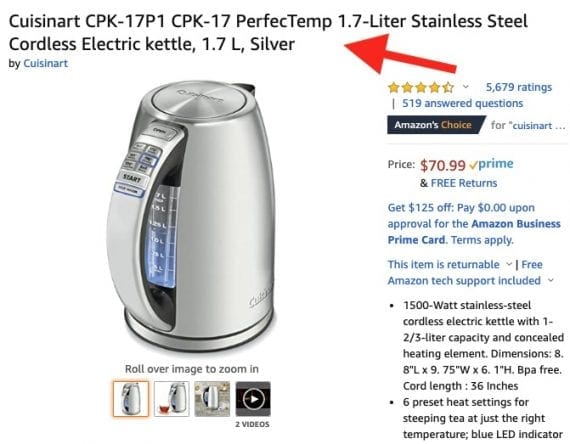Product detail pages on Amazon rank for roughly 34 million keywords in Google in the U.S. In this post, I’ll address three tips for optimizing the product pages on your own ecommerce site using lessons from Amazon.
1. Product Names
The name of a product greatly influences organic search rankings. Product names are typically in title tags, heading tags (H1, H2), and other metadata. Search engines use product names for relevance signals, and shoppers use them to scan search-result pages.
Product names are important for Amazon’s site search. Thus merchants tend to go overboard there. The principle, however, is the same for optimizing search on Google or Amazon.
Highly descriptive product names — such as “Deck Plus #10 x 3-in Ceramic Deck Screws” — leave little doubt both to searchers scanning the results page and to search engine algorithms.
However, when a product name is more general, such as “Cuisinart Electric Cordless Tea Kettle,” neither searchers nor engines know with certainty what’s on the page. Which Cuisinart electric kettle is it? Stainless steel or plastic? Big or small?
Product details could appear in less prominent sections of the page. But the strongest signal is the page name.
Naming products is beyond the scope of SEO. But merchants can often augment (but not change) names with short descriptions, such as “Cuisinart Electric Cordless Tea Kettle, Stainless Steel, 1.7 Liters.”
Adding a couple of modifiers helps differentiate it for searchers and engines. Use the same modifiers for SEO as shoppers when they search. Typically one or two attributes stand out, such as color, size, or material. Research keywords research to determine the most prevalent.

The name of this kettle on Amazon leaves little room for confusion: “Cuisinart CPK-17P1 CPK-17 PerfecTemp 1.7-Liter Stainless Steel Cordless Electric kettle, 1.7 L, Silver.”
2. Product Descriptions
Amazon provides two product description sections: at the top as bullets and lower on the page as longer-form text. Both inform Google on relevance.
You can provide the same amount of info regardless of whether your ecommerce platform offers one description section or two. Use bullets to call out quick features and benefits. Use extended text to describe use cases and other details.
Product descriptions can also list options such as color, size, material, style, gender, age, and any other attributes that improve contextual search relevance — and help shoppers.
Remember, searchers have landed directly on your product page from a search engine. They may be unfamiliar with your site and its products. They won’t know, potentially, of a better product option unless you tell them. Otherwise, they could bounce back to search results.
3. User-generated Content
A key Amazon strength for shoppers is its vast amount of user-generated content — reviews and questions and answers. User-generated product information is also an incredible asset for SEO — boosting contextual relevance by using shoppers’ language to augment merchant descriptions and thus helping the page to rank.
Most ecommerce sites implement reviews correctly so that search engines consider them part of the product page.
But UGC can also have the opposite effect. Reviews with irrelevant comments or outright spam can muddle the page’s relevance signals and decrease its ability to rank.
So make sure someone is moderating reviews. Amazon crowd-sources this time-consuming function by enabling shoppers to indicate which reviews are helpful. The helpful reviews are pinned to the top of the list, which contributes to the page’s keyword theme and pushes less useful reviews out of prominence.
Amazon’s internal search scours the entire product page — descriptions, reviews, Q&A — for any word or phrase. By itself, Amazon’s search serves no SEO value for web search (Google). But it’s another way that Amazon reinforces value to shoppers.
March 8, 2020 at 12:16PM
via https//www.brucedayne.com/
Jill Kocher Brown, Khareem Sudlow
